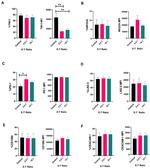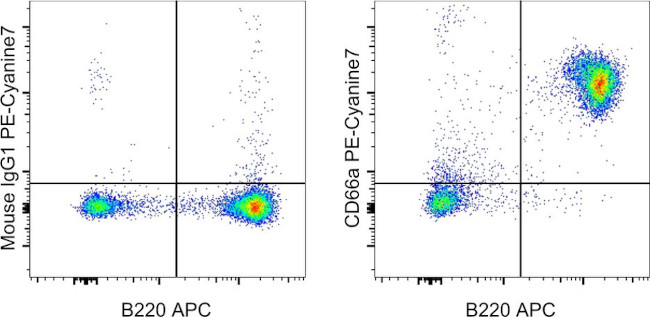Search Thermo Fisher Scientific
Invitrogen
CD66a (CEACAM1) Monoclonal Antibody (CC1), PE-Cyanine7, eBioscience™
FIGURE: 1 / 3
CD66a (CEACAM1) Antibody (25-0661-81) in Flow



Product Details
25-0661-81
Species Reactivity
Published species
Host/Isotype
Recommended Isotype Control
Class
Type
Clone
Conjugate
Excitation/Emission Max
Form
Concentration
Purification
Storage buffer
Contains
Storage conditions
Shipping conditions
RRID
Product Specific Information
Description: The monoclonal antibody CC1 recognizes CD66a, also known as carcinoembryonic antigen-related cell adhesion molecule 1 (CEACAM1), biliary glycoprotein, and BPG. Expression of CD66a is found on brush borders, epithelial, and endothelial cells. In hematopoietic cells expression is found abundantly on B cells, as well as some NKs, monocytes, DCs, and granulocytes. Although low levels of mRNA have been identified in T cells in humans, resting mouse T lymphocytes are not reported to express CD66a, as confirmed by lack of staining with CC1 antibody. In humans, expression levels of CD66a have been used to identify malignancies. CD66a plays a key role as a regulator of BCR activation of B lymphocytes.
An alternate allele, CEACAM1b, is expressed in SJL mice; therefore, CC1 does not stain SJL tissue.
The monoclonal CC1 has been shown to block viral infection and also enhance B cell proliferation when combined with IgM crosslinking.
Applications Reported: This CC1 antibody has been reported for use in flow cytometric analysis.
Applications Tested: This CC1 antibody has been tested by flow cytometric analysis of mouse splenocytes. This may be used at less than or equal to 0.125 µg per test. A test is defined as the amount (µg) of antibody that will stain a cell sample in a final volume of 100 µL. Cell number should be determined empirically but can range from 10^5 to 10^8 cells/test. It is recommended that the antibody be carefully titrated for optimal performance in the assay of interest.
Light sensitivity: This tandem dye is sensitive to photo-induced oxidation. Please protect this vial and stained samples from light.
Fixation: Samples can be stored in IC Fixation Buffer (Product # 00-8222-49) (100 µL of cell sample + 100 µL of IC Fixation Buffer) or 1-step Fix/Lyse Solution (Product # 00-5333-57) for up to 3 days in the dark at 4°C with minimal impact on brightness and FRET efficiency/compensation. Some generalizations regarding fluorophore performance after fixation can be made, but clone specific performance should be determined empirically.
Excitation: 488-561 nm; Emission: 775 nm; Laser: Blue Laser, Green Laser, Yellow-Green Laser.
Target Information
CEACAM1 is a member of the carcinoembryonic antigen (CEA) gene family, which belongs to the immunoglobulin superfamily. Two subgroups of the CEA family, the CEA cell adhesion molecules and the pregnancy-specific glycoproteins, are located within a 1.2 Mb cluster on the long arm of chromosome 19. Eleven pseudogenes of the CEA cell adhesion molecule subgroup are also found in the cluster. The encoded protein was originally described in bile ducts of liver as biliary glycoprotein. Subsequently, it was found to be a cell-cell adhesion molecule detected on leukocytes, epithelia, and endothelia. The encoded protein mediates cell adhesion via homophilic as well as heterophilic binding to other proteins of the subgroup. Multiple cellular activities have been attributed to the encoded protein, including roles in the differentiation and arrangement of tissue three-dimensional structure, angiogenesis, apoptosis, tumor suppression, metastasis, and the modulation of innate and adaptive immune responses. Multiple transcript variants encoding different isoforms have been reported, but the full-length nature of only two has been determined.
For Research Use Only. Not for use in diagnostic procedures. Not for resale without express authorization.
How to use the Panel Builder
Watch the video to learn how to use the Invitrogen Flow Cytometry Panel Builder to build your next flow cytometry panel in 5 easy steps.
Bioinformatics
Protein Aliases: BGP-1; Biliary glycoprotein 1; Biliary glycoprotein D; carcinoembryonic antigen 1; carcinoembryonic antigen 7; Carcinoembryonic antigen-related cell adhesion molecule 1; CD66a; CEA-related cell adhesion molecule 1; hepatitis virus (MHV-4) susceptibility; hepatitis virus receptor; MHV-R; MHVR1; Murine hepatitis virus receptor
Gene Aliases: bb-1; Bgp; Bgp1; C-CAM; Cc1; CD66a; Cea-1; Cea-7; Cea1; Cea7; Ceacam1; Hv-2; Hv2; mCEA1; Mhv-1; MHVR; MHVR1; mmCGM1; mmCGM1a; mmCGM2
UniProt ID: (Mouse) P31809
Entrez Gene ID: (Mouse) 26365

Performance Guarantee
If an Invitrogen™ antibody doesn't perform as described on our website or datasheet,we'll replace the product at no cost to you, or provide you with a credit for a future purchase.*
Learn more
We're here to help
Get expert recommendations for common problems or connect directly with an on staff expert for technical assistance related to applications, equipment and general product use.
Contact tech support

